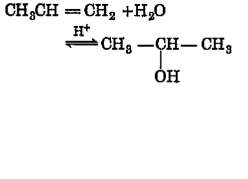Dihydrogen reacts with CO at 700 K in the presence of a catalyst ZnO/Cr2O3 to form formaldehyde.
To determine whether the statement "Dihydrogen reacts with CO at 700 K in the presence of a catalyst ZnO/Cr2O3 to form formaldehyde" is true or false, we can analyze the reaction step by step.
1. Understanding the Reactants and Conditions:
- The reactants in this scenario are dihydrogen (H2) and carbon monoxide (CO).
- The reaction occurs at a temperature of 700 K.
- A catalyst composed of zinc oxide (ZnO) and chromium(III) oxide (Cr2O3) is used.
2. Catalyst Role:
- Catalysts are substances that increase the rate of a chemical reaction without being consumed in the process.
- The choice of catalyst is crucial as it can influence the selectivity of the reaction, meaning it can lead to different products depending on the catalyst used.
3. Possible Products:
- When dihydrogen reacts with carbon monoxide, the products can vary based on the catalyst:
- In the presence of nickel, the reaction can yield methane (CH4) and water (H2O).
- In the presence of copper, it can yield methanol (CH3OH) or formaldehyde (HCHO).
- The specific catalyst used (ZnO/Cr2O3) is known to favor the formation of formaldehyde.
4. Reaction Pathway:
- The reaction pathway can be illustrated with an energy activation graph, showing that the catalyst provides an alternative pathway with a lower activation energy for the reaction to occur.
5. Conclusion:
- Given that the ZnO/Cr2O3 catalyst is known to facilitate the formation of formaldehyde from the reaction of dihydrogen and carbon monoxide at 700 K, the statement is True.
Final Answer:
The statement is True.
- The reactants in this scenario are dihydrogen (H2) and carbon monoxide (CO).
- The reaction occurs at a temperature of 700 K.
- A catalyst composed of zinc oxide (ZnO) and chromium(III) oxide (Cr2O3) is used.
- Catalysts are substances that increase the rate of a chemical reaction without being consumed in the process.
- The choice of catalyst is crucial as it can influence the selectivity of the reaction, meaning it can lead to different products depending on the catalyst used.
- When dihydrogen reacts with carbon monoxide, the products can vary based on the catalyst:
- In the presence of nickel, the reaction can yield methane (CH4) and water (H2O).
- In the presence of copper, it can yield methanol (CH3OH) or formaldehyde (HCHO).
- The specific catalyst used (ZnO/Cr2O3) is known to favor the formation of formaldehyde.
- The reaction pathway can be illustrated with an energy activation graph, showing that the catalyst provides an alternative pathway with a lower activation energy for the reaction to occur.
- Given that the ZnO/Cr2O3 catalyst is known to facilitate the formation of formaldehyde from the reaction of dihydrogen and carbon monoxide at 700 K, the statement is True.
The statement is True.
Topper's Solved these Questions
- HYDROGENBOOK - MODERN PUBLICATIONCHAPTER - HYDROGENEXERCISE - REVISION EXERCISES (Fill in the blanks Questions)
10 Videos
- HYDROGENBOOK - MODERN PUBLICATIONCHAPTER - HYDROGENEXERCISE - REVISION EXERCISES (Assertion Reason Questions)
10 Videos
- HYDROGENBOOK - MODERN PUBLICATIONCHAPTER - HYDROGENEXERCISE - REVISION EXERCISES (OBJECTIVE/VERY SHORT ANSWER QUESTIONS)
10 Videos
- HYDROCARBONSBOOK - MODERN PUBLICATIONCHAPTER - HYDROCARBONSEXERCISE - UNIT PRACTICE TEST
15 Videos
- MOCK TEST -1BOOK - MODERN PUBLICATIONCHAPTER - MOCK TEST -1EXERCISE - SECTION -D
2 Videos
Similar Questions
Knowledge Check
Dihydrogen reacts with CO at 700 K in the presence of a catalyst to form methanol, the catalyst is:
AZnO.C2O3BZnO.C2O4CZnO.CrODZnO.Cr2O3Dihydrogen reacts with CO at 700 K in the presence of a catalyst to form methanol, the catalyst is
AZnO.C2O3BZnO.C2O4CZnO.CrODZnO.Cr2O3Cl2 reacts with CS2 in presence of I2 catalyst to form
ACHCl3BCCl4CC2H5ClDC2H6
Toluene reacts with chlorine in presence of catalyst FeCl3 to form______.
View SolutionAcetic acid reacts with chlorine in the presence of catalyst, anhydrous FeCl3 to give:
View SolutionBenzaldehyde reacts with formaldehyde in the presence of alkali to form:-
View SolutionAlkenes react with water in the presence of acid as catalyst to from alcohols.

The reaction takes place in accordance with
View SolutionMonocarboxylic acids react with alcohols in presence of an acid catalyst to form:
View Solution
